#Philip II of macedon
Explore tagged Tumblr posts
Photo
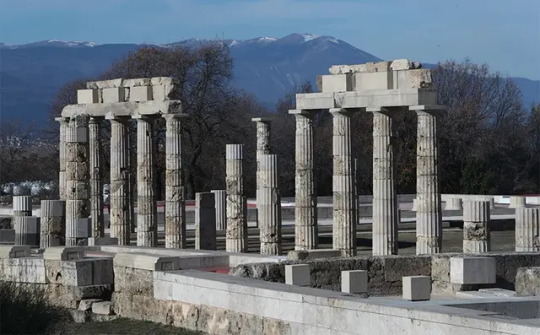
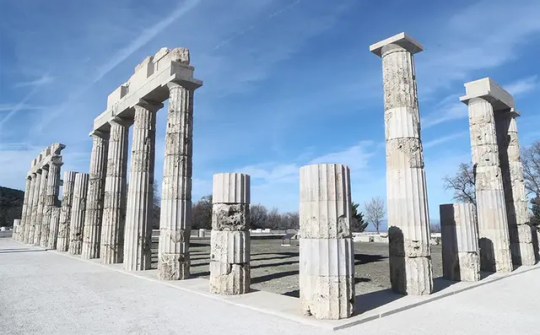
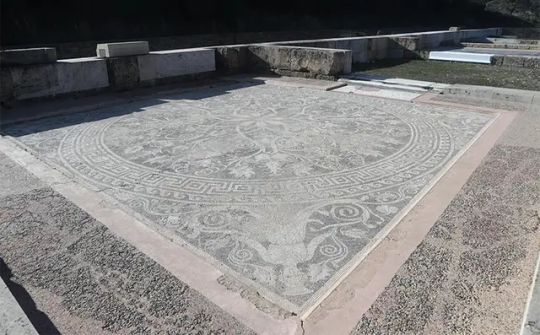

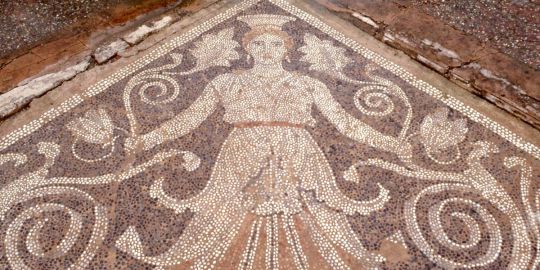
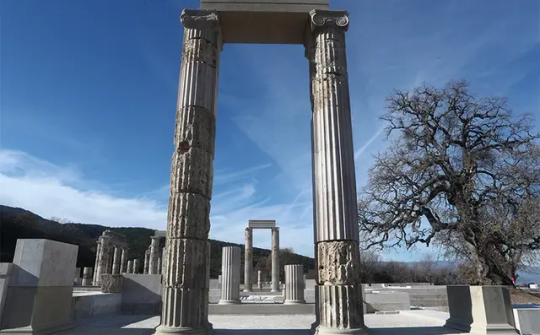
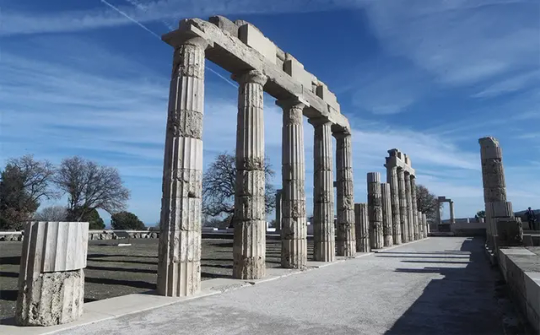
Photos from the Palace of Aegae (~ 350 BC), the royal residence of Philip II of Macedon and his son Alexander the Great, in Aegae, Imathia, Greece. The site can be visited after being closed for many years but it is still under reconstruction works.
Source of the mosaic close-up
Source of the rest of the photos
#greece#europe#alexander the great#philip ii of macedon#ancient greece#macedonia#imathia#aegae#palace of aegae#mainland#greek culture#greek facts#greek history
206 notes
·
View notes
Note
Did Alexander have a sense of humor?
Yes, I think he did. But it wasn't quite as...quick-witted?...as his father's. I get the impression Philip was truly FUNNY. But yes, I think Alexander had a sense of humor, and sometimes it had a bite. I'm not sure, however, that anybody would have called him a wit.
In the novels, I tried to distinguish a bit in how I understand their senses of humor. As a survival tactic, I suspect Philip learned to laugh at himself--but also at others. He could be mean in his humor, while pretending not to be. He had a dark humor at times, and natural timing, as well as a sense of the absurd. He could tell a joke.
Alexander's humor was more straightforward, I suspect. He could also be mean in his humor, but he was deliberate about it. I don't see him as making fun of people in a funny sideswipe. If he went after you with humor, you'd wronged him, in his eyes. I think he was also more...joyous?...in his sense of humor. He liked things that were innocently funny. Ironically, I don't think he was a particularly good joke-teller, although he could laugh at one. I also don't think he generally took pleasure in somebody else being made fun of...unless (again) that person had wronged him in some way: e.g., he thought the person deserved it.
I have little in the way of evidence for either opinion. It's just a sense I have.
#asks#Alexander the Great#Philip II of Macedon#Philip of Macedon#Alexander of Macedon#Philip's sense of humor#Alexander's sense of humor
25 notes
·
View notes
Text

New art for my novel! Pausanias of Orestis being his usual disaster self, by the.angel.incarnate!
Probably 10% of Book 1 is "Pausanias NO", the rest being split between "Philippos WHY?", "Alexandros I'm not sure that's a great idea" and "Hephaistion YOU SHOULDN'T" lol.
One note: Pausanias's "plotline" starts a few years after the point when it did historically, so I could better involve Alexandros and Hephaistion in the whole thing. So he was with Alexandros in Mieza at some point, and started his affair with Philippos when Alexandros, aged 16, received the regency.
***
"I don't understand you, Hephaistion - why would you fuck a nobody, an hostage no one likes, when you could have much better?" "We don't fuck," I hissed.
"Well," Pausanias said, "is that relevant? Poor Alexandros believes you do."
"So? What I do in my bed is none of his business."
Pausanias leaned against the wall. Watched me, puzzled and then amused, as if he had suddenly understood the funniest thing.
"Oh my, Hephaistion, you're unbelievable... you haven't noticed? Not at all? Let me spell that for you: Alexandros is th-i-rst-y for you. How can you not know? Everyone in Mieza noticed!"
Well, I hadn't, and I didn't care: I had a man to kill tonight and this wretched party was keeping me from my mission - this whole stupid talk was.
"I'll pass," I said, trying to walk away, only for Pausanias to grab my arm.
"Just picture what you're missing, Hephaistion: you're from an obscure family and new to Makedon. Alexandros could bring you money, power, status. And for what price? He's a pretty boy."
"You're welcome to him," I said, breaking free of his grip. Maybe the real Hephaistion would have hoped for all that, but as a Hunter of Artemis, I couldn't care less.
I hoped Pausanias would understand, then, that I was busy and in no mood to talk to him. If I couldn't leave to hunt, I least I could pretend to do my job as a page and go back to serving plates and wine. But no, he kept close, and told me with a grin:
"Thank you but no. I'm tired of dating fumbling virgins - I want a man while I still can... and I'm quite sure by the end of the feast, I won't be sleeping alone."
He flashed me another smile and then mouthed: think about Alexandros, before we were engulfed in the flow of servants.
#my stories#la fleche d'artemis#alexander the great#ancient greece#ancient history#philip ii of macedon#hephaestion
24 notes
·
View notes
Text






The Army of Alexander the Great
Alexander the Great's soldiers were some of the most disciplined, innovative, and battle-hardened forces of the ancient world. His army was primarily composed of Macedonian and Greek troops, augmented by soldiers from conquered regions as his empire expanded. Here’s a brief overview of key elements of Alexander’s military forces:1. The Macedonian PhalanxCore Infantry: The backbone of Alexander's army, the phalanx consisted of tightly-packed infantry armed with the sarissa, a 4-6 meter (13-20 feet) long spear.Formation: Soldiers in the phalanx operated in close ranks, creating an impenetrable wall of spear points. Their discipline and cohesion were unmatched.2. The Companion Cavalry (Hetairoi)Elite Cavalry: The most prestigious unit, composed of noble Macedonians who served as Alexander’s shock troops.Role: They carried out devastating charges, often led personally by Alexander himself, breaking enemy lines and exploiting weaknesses.3. The HypaspistsElite Infantry: Highly-trained and versatile soldiers who acted as a bridge between the phalanx and cavalry.Role: They protected the vulnerable flanks of the phalanx and participated in siege warfare and special missions.
From "The Army of Alexander the Great"
#military art#history#military#soldier#cavalry#alexander the great#alexander of macedon#philip ii of macedon#greek history#macedonian history#ancient greece#late antiquity
21 notes
·
View notes
Text

Philip II of Macedon for Charlene Ferlay ⭐️ This image belongs to the story "La Flèche d'Artémis" ("Arrow of Artemis"; you can read it on Wattpad in French).
45 notes
·
View notes
Text
Guys is this a safe space to say that Demosthenes and Philip II should have fucked nasty
#no this has nothing to do with the assassin's creed game I don't know shit about ac odyssey#what I do know shit about is my greek history college exam#old men yaoi I raise you ancient men yaoi#demosthenes they could never make me hate you#but I want too se you chocked like you SHOULD HAVE BEEN PUTTING PEBBLES IN YOUR MOUTH WHAT THE FUCK WAS THAT BESTIE#bitches with linguistic impediments and hater reputations just get eachothers (me and demosthenes are the bitches)#I don't think that fucking the king of Macedon would have helped with Greece's political situation or would have somehow made#Greece's submission to Macedon have better conditions#I just think that if you write four callout posts about a guy maybe it's more productive to fuck him rather than considering writing a fifth#demosthenes#philip ii#philip ii of macedon#ancient history#ancient greece
19 notes
·
View notes
Text
I've always been astounded by the absolute barbarity employed by the Argead Dynasty (the one that Alexander the Great was part of) to bullshit their way into recognition by Greece.
You know, Alexander the First, (would be) King of Macedon, saw the Olympic Games and wanted to participate. I imagine the conversation going like this
ALEXANDER: -" I want to do that too"-
HELLANODIKAI: -" Greeks only"-
ALEXANDER: -" well of course Greeks only my friends, because I am in fact Greek, my whole family comes from Argos"-
HELLANODIKAI: -" wdym your family comes from Argos, you're the literal Prince of Macedon, this is bullshit"-
ALEXANDER: -" you know what Mr. Olympia, I didn't wanna brag but you forced me to, because I'm not only Greek, but a descendant of Herakles himself"-
HELLANODIKAI: -" we'll have to look into this.
And then they fucking granted him permission to take part in the Olympic Games because they believed his bullshit.
He then proceeded to model his court after the "Court of the Athenian Kings" despite not being a court nor kings in Athens.
He was later named Philellenos after the Persian wars, but the Greeks didn't know he offered and actively gave assistance to both sides and was probably banking on getting on the good side of whoever would have won the war, to then get power and money.
Alexander also tried bullshiting the Persians into recognition by (most probably) giving away his sister in marriage to a Vassal of the Achaemenid Empire and General of Persia. He also frequently bribed Persian officials to give embellished reports about Macedon. His turnaround to Greece might have been dictated by his own failure to get recognised as a full on Vassal by the Achaemenid court (and the subsequent forced submission of Macedon).
Sometimes I stop to think that we could have had a Persian Alexander the Great, reincarnation of Verathragna, conquering all of Europe instead. If just his great-great-great-great grandfather managed to bullshit the Persians instead of the Greeks.

#ancient history#archaeology#ancient greece#ancient art#history#art#alexander the great#philip ii of macedon#alexander of macedon#ancient macedonia#ancient persia
10 notes
·
View notes
Text
The phrase 'Philip and Olympias feared Alexander was becoming a femme homosexual' was just uttered in a documentary in my classical studies class
I cannot take this video seriously as it wants me to take it seriously I fear
Also refered to Philip as 'this successful heavy drinking, dominant alpha male'
#wolffox speaks#ancient history#ancient greek#Greek#alexander the great#philip ii of macedon#olympias#classical studies
11 notes
·
View notes
Note
What of Olympias in her marriage to Philip II? It is said to be quite stormy and he has many other wives.
Hello! I love this period of history and have read up quite a bit about it, but I'm definitely not an expert. Most of my information from this answer has been taken from Olympias by Elizabeth D. Carney, which I enjoyed a great deal and would recommend.
To get straight to the point - polygamy was likely to have been a standard practice among Macedonian kings by the time Philip II came to the throne (see this article for more information on the topic), although it's certainly true that Philip practiced it on a particularly extravagant level: he had seven recorded wives, and many other lovers, possibly including Olympias' own brother. However, since Olympias was his fourth or fifth wife, she would have surely been aware of this and prepared for it before she married him. Even if it was a shock to her at the time of her marriage, she would have had almost two decades to become accustomed to it. She may have even been close to Nicesipolis, another one of Philip’s wives, as she might have raised her young daughter, Thessalonike, after Nicesipolis died in childbirth.
Moreover, these kinds of high-level marriages weren’t for love; they were for politics. The few ancient sources that frame Philip and Olympias’s union as love match have to be discarded: it’s logistically impossible for this to have been the case, as they had been betrothed since Olympias was a very young child.
After they married, they had two known children: Alexander and Kleopatra. It’s true that their marriage is (and was) often viewed as very volatile, but this is generally tied to the oft-repeated misogynistic view of Olympias as a difficult and temperamental woman. They seem to have gotten along for the most part, considering Philip II had an agent shopping for Olympias from Athens as late as 341 B.C.E. Moreover, we probably shouldn’t let Olympias’ later actions during Alexander’s reign and Wars of the Diadochi cloud our judgement of her earlier years – during her marriage, she seems to have played a generally conventional role for a Macedonian royal woman. Either way, we don’t know what either spouse thought of each other on a personal level, and I don't think it would have mattered much on a practical level either way.
Eventually, Olympias became the dominant woman at court, as she was one of the only two wives of Philip who gave birth to a living son. More importantly, by the time he reached his teens, Alexander – the future Alexander III – was regarded as his father’s eventual heir. (His brother, Arrhidaeus, seems to have been mentally disabled in some way, which unfortunately affected how contemporaries viewed him). However, it’s important to note that this was not a formalized hierarchy or ranking system as it was in, say, Persia (there was no such thing as a “chief wife”), but inherenty informal, precarious and subject to change.
It’s true, though, that their marriage seems to have become very tense in later years. Namely, Philip II’s last marriage to Kleopatra-Eurydice provoked a visceral and negative reaction from both Alexander and Olympias. Again, this is not because Olympias was a volatile, jealous, power-hungry bitch as she is often depicted in ancient sources and historical fiction, but because the wedding resulted in dishonor to both her and Alexander. Attalus, Kleopatra Eurydice’s uncle and guardian, had apparently insulted and threatened both mother and son during the ceremony, which Philip II did not rebuke him for and thus tacitly condoned (That being said, Alexander's reaction to Attalus also out-of-line, as was Philip's reaction to Alexander). More crucially, the marriage placed Olympias and Alexander's own political positions in potential jeopardy should Kleopatra-Eurydice have a son (at least, based on the insults Attalus levelled at them). Accounts for the wedding incident somewhat differ, but all agree that it resulted in Alexander taking himself and his mother away from Macedon in protest. Justin then claimed that Olympias tried to persuade her brother in Molossia to declare war on Philip. We have no idea if this is true or not, but Carney believes that it is at least "somewhat convincing".
It is sometimes believed that the marriage Philip subsequently arranged between his and Olympias’ daughter, Kleopatra and Alexander I of Epirus (Olympias’s brother and Philip’s possible former lover) was meant to deprive mother and son of a potential ally. However, this is far likelier to have been Philip’s desire to effect a public reconciliation between them, demonstrating that his household troubles were over and mollifying his son and his wife for the humiliation they had endured. It was also probably an attempt to stabilize the somewhat rocky Molossian alliance. The vital importance of the wedding is demonstrated by how Philip transformed it into an international festival in its own right, complete with public performances and processions where Philip walked between the two Alexanders. That doesn't mean that there may not have been cracks and that the reconciliation efforts were partial rather than entirely sincere (as suggested by Plutarch), but progress was undoubtedly being made. At the very least, it seems pretty clear to me that Philip still considered Alexander his heir.
Ultimately, however, we will never know what would have happened next between Philip, Olympias and Alexander. Philip was murdered at his daughter's wedding by Pausanias (his former lover who he had wronged very badly) and Alexander took the throne in 336 B.C.E. And no, while we don't know what they felt about Philip's murder, it's very unlikely that Alexander or Olympias were actively involved in it. It can't be proven or disproven by any explicit evidence, but as Carney has observed, "the circumstances of the murder strongly argue against their participation."
I hope this was helpful! As I said, I have read up a lot about this era but am not an expert, so if I've gotten anything wrong or mixed up, do let me know!
#ask#I was getting very stressed about this but figured I should just post it#I may edit it a bit later#Olympias#Philip II of Macedon#macedonian history#greek history#ancient greece
8 notes
·
View notes
Text

Demosthenes talking about Philip II of Macedon.
Click below for "artist rendering" and for the reference (and yes, it's a Hazbin Hotel reference).
Artist Rendering:

Reference:

#demosthenes#philip ii#philip ii of macedon#ancient greece#tagamemnon#hazbin hotel#hazbin hotel reference#hazbin hotel vox
24 notes
·
View notes
Text
Philip II : For the last time, Alexander, you cannot be a part of this family if you are a satanist!
Alexander : ...
Alexander : I was literally just eating a salad.
#alexander the great#alexander the making of a god#philip ii of macedon#I have a hyper fixation on Alexander the Great#and the docu-series is very good#I'm gay and autistic#what more do you need to love Alexander#incorrect quotes
20 notes
·
View notes
Text
Some Guy: I wouldn't touch that with a 20 foot pole!
Philip II of Macedon: ...what did you just say?
#Philip of Macedon#philip ii#philip ii of Macedon#alexander the great#Macedonian Empire#Macedonian sarrisa
0 notes
Note
How important was it, really, that Alexander didn't have more brothers? He had Karanos, and it there's the gossip that ATG or his mother killed the boy. Philip Arridhaios apparently wasn't seen as a direct challenge and ATG kept him around. But if Philip had more healthy male offspring around Alexander's age, would that have threatened his hold on power, the partition of the empire or even the military campaigns themselves (the brothers becoming generals for example)?
Philip’s (Lack of) Sons
So, first I need to correct the bit about Karanos. He didn’t exist. Justin gave baby Europē a sex-change. No historian reports two children for Kleopatra Eurydikē, and Justin alone names a boy. We get two children when modern historians try to reconcile Justin and Diodoros/others. But Justin gets things wrong a lot. So, where Justin disagrees with other historians, I’ll go with the others (especially if it’s more than one). Justin wasn’t simply epitomizing Pompeius Trogus; he had his own agendas and themes, so he changed things when it suited him.
Therefore, “Karanos” = Europē,* born just a few days (maybe a week or two) before Philip’s murder.
The wives and children of Philip are reported in a fragment from Satyrus preserved in Athenaeus (13.557b-c). Of his (living) children, we have four girls (Kynannē, Kleopatra, Thessalonikē, and Europē), and only two boys (Arrhidaios and Alexander).
I specify living because ancient accounts don’t usually list children who died young unless it somehow impacted events. So, the murder of Europē, which led to the suicide of Kleopatra Eurydikē, means Europē got a mention whereas if she’d died of some childhood disease, we’d probably not hear about her.
Ergo, it’s possible Philip did sire other children who simply didn’t survive long enough to make it into the histories—especially if they’d been born (and died) in his earlier years. In Dancing with the Lion, I invented a son (Menelaos) by the shadowy Phila of Elimeia, who died young, specifically to illustrate that point.
The two-to-four ratio of boys to girls suggests Philip fathered girls more than boys. Would more boys have endangered Alexander’s place? Certainly, if they were around his age. But not if they were notably younger—another point I make in Dancing with the Lion: why Alexander is less upset by Philip’s seventh marriage than his mother. The chance that Kleopatra Eurydike might bear a male child threatened Olympias’s position far more than Alexander’s. Even some of my colleagues seem to forget that. While yes, sons and mothers did form a political unit at polygamous courts, that doesn’t mean that threats to the mother’s status necessarily entailed threats to a son’s. Philip’s marriage to Kleopatra Eurydikē was just such a case. Any son she produced would’ve been so far behind Alexander in achievements (and thus, a shot at the throne), that the marriage was no threat—which is why he attended the wedding. That makes events at the wedding very curious indeed! And convinces me that we don’t even begin to have the whole story there.
I made up some things in Rise (no spoilers), precisely because we don’t know and I had to come up with something that didn’t make Alexander into a reactionary rube. Too often people point to him as a “hotheaded youth” who made a mountain out of a molehill at his mother’s instigation. Folks, he was eighteen or nineteen. Hotheaded (always), but not some little kid to jump at shadows and Mommy’s tales. Something truly threatening generated that level of reaction from him (and beyond what Diodoros relates at the wedding). It wasn’t fear of being replaced by an as-yet-not-even-conceived infant brother--unless Philip had other reasons to replace him, and there weren’t any … on the face of it.
Anyway, I want to end by pointing to the Big Pink Elephant in the room that way too many people seem to forget….
AMYNTAS PERDIKKA was Alexander’s chief rival, not Arrhidaios or a fictional infant brother. Amyntas was older than Alexander, the only son of Philip’s older brother Perdikkas (III), who’d been king before Philip. Amyntas didn’t become king when his father died in battle precisely because he was only about a year old, while Philip was c. 23/24, and the kingdom was in crisis. Being a baby was also why Philip didn’t kill him. He needed an heir until he could father his own.**
So despite being the eldest Argead after Philip and the legitimate son of a former king, Amyntas spent his life as “the spare.” Imagine the resentment that would have generated. It’s not an accident that Alexander had him killed inside six months of taking the throne. And it’s probably in that time frame that Amyntas would’ve staged a bid for the throne himself. After all, not only was he an Argead, with military experience, he was married to Philip’s eldest child, who was already pregnant, showing he was fertile. He had a really good claim.
Such a clearing out of competing Argeads was standard for any new king’s first year or so. It’s what whittled down available Argead males from the five sons (and progeny) of Alexandros I to just three at Philip’s death, a hundred years later: Amyntas, Alexander, and Arrhidaios. Alexander wasn’t unique in house-cleaning. Philip had killed his three half-brothers upon taking the throne, keeping only Amyntas, his nephew. This was so typical it’s of note that Alexandros II not only didn’t get rid of Perdikkas (III) or Philip (II), but kept around his half-brothers too. It was the exception, not the rule (perhaps because all of them were still too young to be a threat?).
So basically, given Argead patterns, the survival of male siblings/cousins depended on a couple things:
The age of the sibling(s)/cousins. Siblings and half-siblings who were notably younger were likely to be spared if they didn’t appear to offer an immediate threat. After all, the new king needed an heir until he could father his own.
The apparent competence of the sibling(s)/cousins. Arrhidaios is our best evidence for this: Alexander took him with him to Asia to keep an eye on him—prevent his use as a stooge in a coup—but he otherwise kept him alive.
The king’s personal relationship with the sibling(s)/cousins. This is obviously very hard to determine, as our sources may not tell us, or not tell us honestly, but even if it’s hard, that doesn’t mean we should neglect it as a possible motivating factor. It may, in fact, explain why Alexander II (Philip’s older brother) didn’t kill his siblings. He may have loved them (and them, him). While we can’t say from the evidence, we also shouldn’t dismiss that as a possible motivating factor.
Here's an earlier posts about Amyntas, btw.
AMYNTAS PERDIKKA
* The names themselves are a give-away. “Europē,” like “Thessalonikē” was bestowed in celebration of Philip’s military victories. By contrast, “Karanos” (which means generic “chief”) isn’t a royal Macedonian name at all. Bill Greenwalt talks about the name’s significance in one of his articles, but I can’t now recall which.
** There is some question as to whether Amyntas was ever king, however briefly, due to a reference to an “Amyntas IV.” But many of us believe that was part of a challenge to Alexander later, not proof that Amyntas was king briefly, and Philip his regent.
#asks#Philip II of Macedon#Philip of Macedon#Alexander the Great#Arrhidaios#Perdikkas III of Macedon#Alexander II of Macedon#Amyntas Perdikka#ancient macedonia#Argead Macedonia#Inheritance in Argead Macedonia#Karanos#Justin lies
26 notes
·
View notes
Text
Kleitos the Black

Art by TheAngelIncarnate on Instagram, for my story La Flèche d'Artémis !
He looks angry and tbh he is often angry! However, he's probably the character of the cast who is the most into caring for everyone else.
What we know about him is that is the brother of Lanike, Alexander's nurse, and that he had a brilliant career as a cavalry officer until Alexander killed him in a drunken quarrel. The quarrel reveals that Kleitos was loyal to Alexander's father Philip.
More below about Kleitos in my novel.
In Pressfield's The virtues of war, Kleitos is shown as Philip's eromenos and I really liked this idea, especially since Philip was older but not *that much* older.
In my story, Kleitos and Philippos were hostages in Thebai together, in the same house, with Kleitos looking up to the older prince. They later met again when Kleitos came to Pella as a royal page, in the last weeks of Perdikkas' reign. He followed the new regent of Makedonia as his royal page and they started a relationship in the dangerous first month when basically Everyone Wanted To Invade Macedonia. Their relationship was officially Philippos' longest time with one of his page, lasting for two years until he was discarded because of his age.
Very few people know that their relationship never stopped and, at forty and thirty five, they are still together, hiding because dating a grown man is not the best move for someone who wants a military career. They also ditched the eromenos/erastes thing a long time ago and define themselves as equals in the bedroom, though they are very secretive about this.
Because of his bond with Philippos, Kleitos' sister was selected to become Alexandros' nurse and Kleitos always played an important role as a mentor, like a surrogate uncle. He is usually the one Alexandros goes to when he needs to talk to a fatherly figure, since Alexandros and Philippos have a very complicated relationship; the teenager doesn't know about the long lasting love story between the two men until the end of the first book, and let's say that's a discovery that didn't go well.
#ancient greece#ancient history#la fleche d'artemis#philip ii of macedon#alexander the great#my stories
24 notes
·
View notes
Text
Okay, but like, what did Alexander the 'Great' even do? The nepo baby gets an army, kills his cousin, and conquers an empire? Like, good job? But I bet your dad would have done better.
#alexander the great#ancient history#ancient greece#history#Alexander III of Macedon#philip II of Macedon
1 note
·
View note
Text

Second Ancient Statue Found at Bulgaria’s Heraclea Sintica Site
Heraclea Sintica, Bulgaria – Archaeologists have unearthed a second large statue in a sewer in the ancient city of Heraclea Sintica, founded by King Philip II of Macedon, father of Alexander the Great. This discovery comes just months after the July 2024 finding of a near-intact statue, believed to represent the god Hermes, in the same sewer system.
The newly discovered statue, like its predecessor, is made of marble and is significantly large. It was found face down in the eastern section of the sewer, close to the location of the Hermes statue.
Professor Ludmil Vagalinski, who is leading the excavation, stated that while the second statue shares a similar artistic style with the first, it presents new challenges for researchers. Notably, the head of the statue was missing. Several days later the head was found in the sewer.


The discovery of the first statue in July fueled speculation that it had been deliberately hidden during the transition from paganism to Christianity. This theory suggests that the owners buried the statue to avoid its destruction.
The proximity of the second statue to the first raises further questions about their placement and purpose. Archaeologists are now working to determine the identity of the subject depicted in the second statue and its connection to the first.




The statue identified as Hermes, initially thought to date back to the 2nd century AD, is now believed to be older, potentially dating back to the 1st century BC. This revised dating, along with a closer examination of the statue’s features, has led some to believe it may not depict Hermes at all, but rather a ruler or another significant figure of that era.
Both statues are significant finds, offering invaluable insights into the history and culture of Heraclea Sintica, a city founded by Philip II between 356 and 339 BC, now located in southwestern Bulgaria.
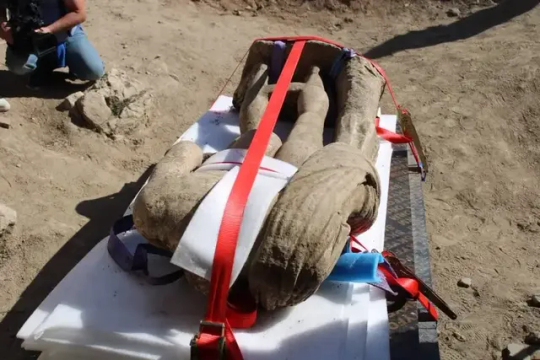



#Second Ancient Statue Found at Bulgaria’s Heraclea Sintica Site#ancient city of Heraclea Sintica#King Philip II of Macedon#marble#marble statue#marble sculpture#ancient artifacts#archeology#archeolgst#history#history news#ancient history#ancient culture#ancient civilizations#macedonia#Ancient Greece#greek history#greek art#ancient art#art history
51 notes
·
View notes